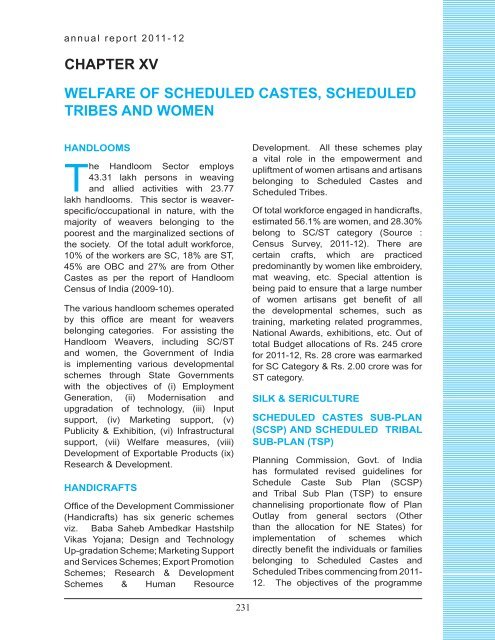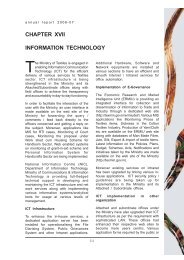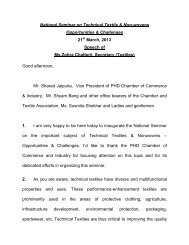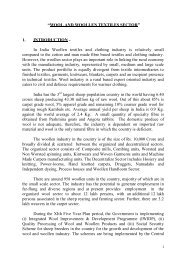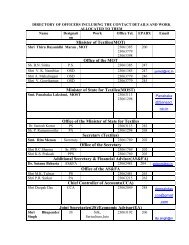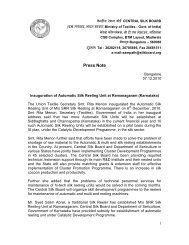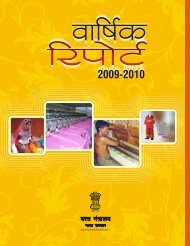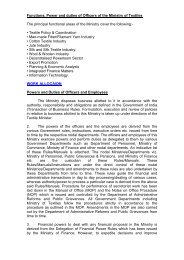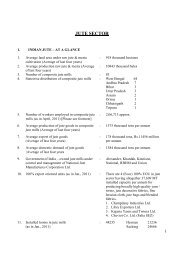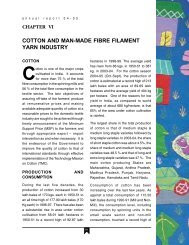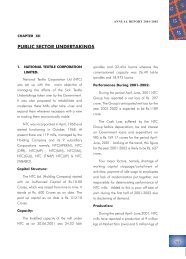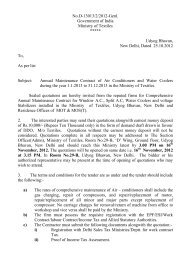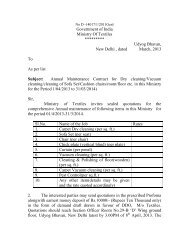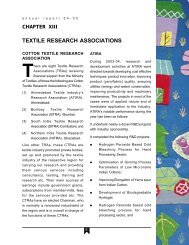chapter viii wool & wollen textiles industry - Ministry of Textiles
chapter viii wool & wollen textiles industry - Ministry of Textiles
chapter viii wool & wollen textiles industry - Ministry of Textiles
You also want an ePaper? Increase the reach of your titles
YUMPU automatically turns print PDFs into web optimized ePapers that Google loves.
annual report 2011-12<br />
CHAPTER XV<br />
WELFARE OF SCHEDULED CASTES, SCHEDULED<br />
TRIBES AND WOMEN<br />
HANDLOOMS<br />
The Handloom Sector employs<br />
43.31 lakh persons in weaving<br />
and allied activities with 23.77<br />
lakh handlooms. This sector is weaverspecific/occupational<br />
in nature, with the<br />
majority <strong>of</strong> weavers belonging to the<br />
poorest and the marginalized sections <strong>of</strong><br />
the society. Of the total adult workforce,<br />
10% <strong>of</strong> the workers are SC, 18% are ST,<br />
45% are OBC and 27% are from Other<br />
Castes as per the report <strong>of</strong> Handloom<br />
Census <strong>of</strong> India (2009-10).<br />
The various handloom schemes operated<br />
by this <strong>of</strong>fice are meant for weavers<br />
belonging categories. For assisting the<br />
Handloom Weavers, including SC/ST<br />
and women, the Government <strong>of</strong> India<br />
is implementing various developmental<br />
schemes through State Governments<br />
with the objectives <strong>of</strong> (i) Employment<br />
Generation, (ii) Modernisation and<br />
upgradation <strong>of</strong> technology, (iii) Input<br />
support, (iv) Marketing support, (v)<br />
Publicity & Exhibition, (vi) Infrastructural<br />
support, (vii) Welfare measures, (<strong>viii</strong>)<br />
Development <strong>of</strong> Exportable Products (ix)<br />
Research & Development.<br />
HANDICRAFTS<br />
Office <strong>of</strong> the Development Commissioner<br />
(Handicrafts) has six generic schemes<br />
viz. Baba Saheb Ambedkar Hastshilp<br />
Vikas Yojana; Design and Technology<br />
Up-gradation Scheme; Marketing Support<br />
and Services Schemes; Export Promotion<br />
Schemes; Research & Development<br />
Schemes & Human Resource<br />
Development. All these schemes play<br />
a vital role in the empowerment and<br />
upliftment <strong>of</strong> women artisans and artisans<br />
belonging to Scheduled Castes and<br />
Scheduled Tribes.<br />
Of total workforce engaged in handicrafts,<br />
estimated 56.1% are women, and 28.30%<br />
belong to SC/ST category (Source :<br />
Census Survey, 2011-12). There are<br />
certain crafts, which are practiced<br />
predominantly by women like embroidery,<br />
mat weaving, etc. Special attention is<br />
being paid to ensure that a large number<br />
<strong>of</strong> women artisans get benefit <strong>of</strong> all<br />
the developmental schemes, such as<br />
training, marketing related programmes,<br />
National Awards, exhibitions, etc. Out <strong>of</strong><br />
total Budget allocations <strong>of</strong> Rs. 245 crore<br />
for 2011-12, Rs. 28 crore was earmarked<br />
for SC Category & Rs. 2.00 crore was for<br />
ST category.<br />
SILK & SERICULTURE<br />
SCHEDULED CASTES SUB-PLAN<br />
(SCSP) AND SCHEDULED TRIBAL<br />
SUB-PLAN (TSP)<br />
Planning Commission, Govt. <strong>of</strong> India<br />
has formulated revised guidelines for<br />
Schedule Caste Sub Plan (SCSP)<br />
and Tribal Sub Plan (TSP) to ensure<br />
channelising proportionate flow <strong>of</strong> Plan<br />
Outlay from general sectors (Other<br />
than the allocation for NE States) for<br />
implementation <strong>of</strong> schemes which<br />
directly benefit the individuals or families<br />
belonging to Scheduled Castes and<br />
Scheduled Tribes commencing from 2011-<br />
12. The objectives <strong>of</strong> the programme<br />
231


